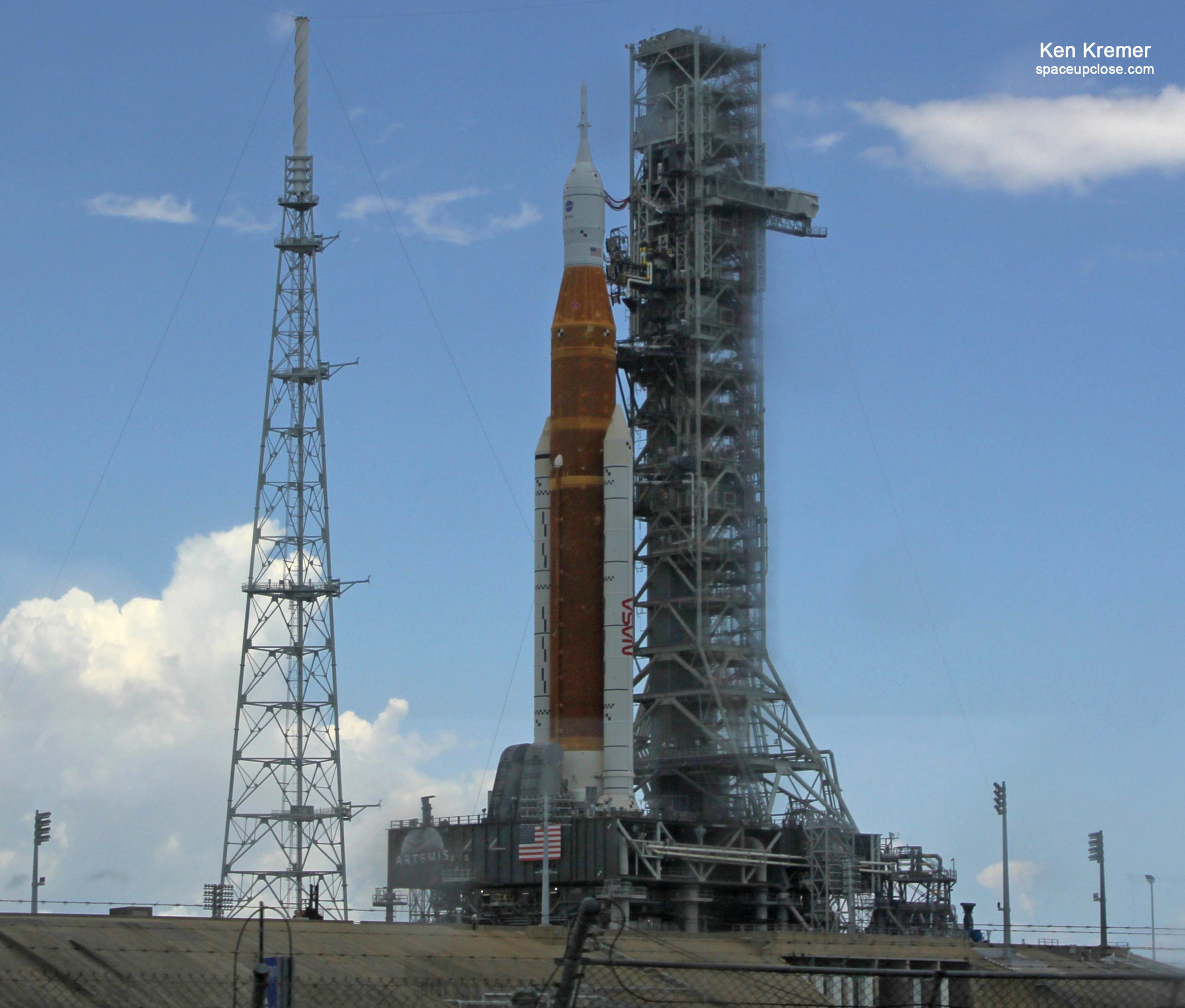
For SpaceUpClose.com & RocketSTEM
KENNEDY SPACE CENTER, FL – NASA decided the 4th Wet Dress Rehearsal (WDR) Tanking Test conducted on the repaired 32- story tall Space Launch System (SLS) rocket on Monday, June 20 was sufficiently successful to declare completion of the practice countdown and cryogenic fueling test campaign objectives despite a new hydrogen leak – and thereby paves the way forward to the long awaited launch of the Artemis 1 mission from NASA’s Kennedy Space Center by no earlier than late Summer.
“NASA’s Artemis wet dress rehearsal is officially complete,” NASA officials said at a June 24 media briefing.
Artemis 1 is the first test flight in NASA’s Project Artemis program to return humans to the Moon for the first time in five decades
The Artemis 1 WDR test concluded at 7:37 p.m. EDT June 20 at T-29 seconds in the countdown ending a 2-day test campaign by fully loading some 750,000 gallons of super cooled liquid oxygen and liquid hydrogen into the SLS rocket core and upper stages after they developed a workaround to the hydrogen leak discovered in a 4-inch quick-disconnect fitting at the bottom of the core stage.
The 4th WDR test had begun on Saturday, June 18, with a call to stations.
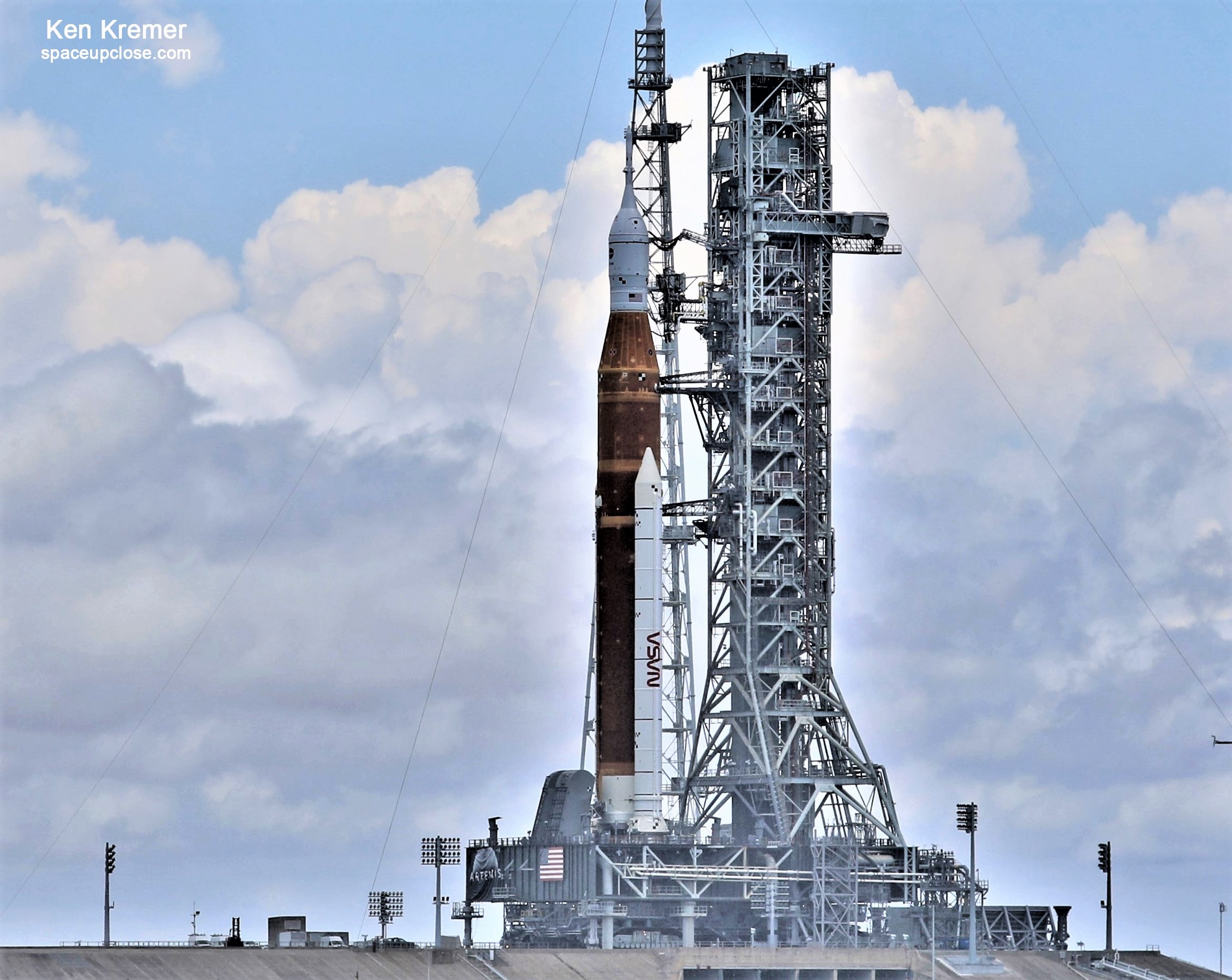
The four core stage RS-25 engines engines were not fired during the countdown test
The Mega Moon rocket 322-foot-tall (98-meter) SLS/Orion crew capsule spacecraft stack will first roll back to the Vehicle Assembly Building (VAB) on July 1 – weather permitting.
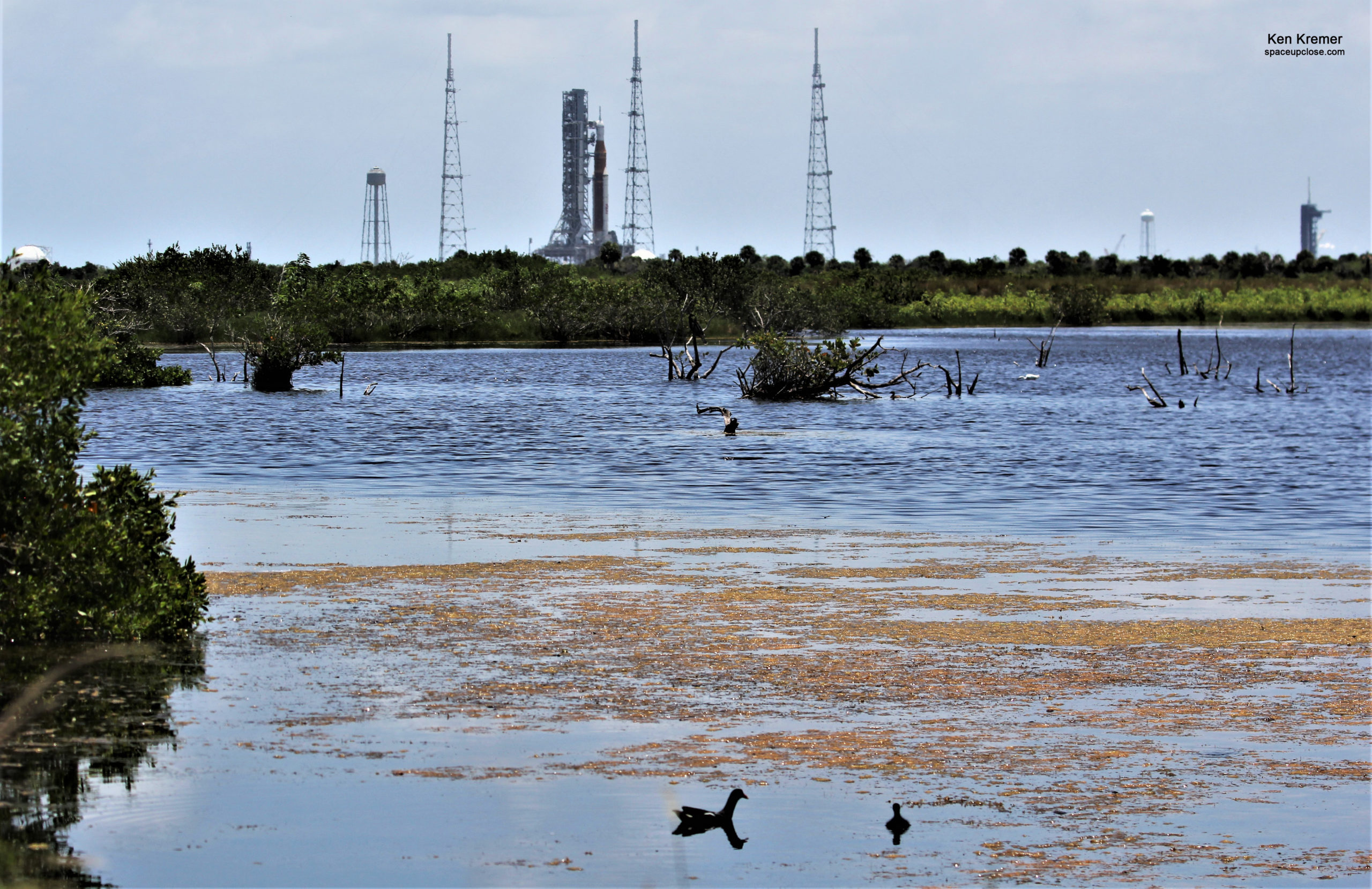
“NASA has analyzed the data from the wet dress rehearsal conducted Monday, June 20, and determined the testing campaign is complete. The agency will roll Space Launch System (SLS) and Orion back to the Vehicle Assembly Building (VAB) at Kennedy next week to prepare the rocket and spacecraft for launch.”
First motion of the 32 story tall SLS/Orion stack is planned for just past midnight at 12:01 a.m. EDT (0401 GMT) July 1 using the crawler-transporter.
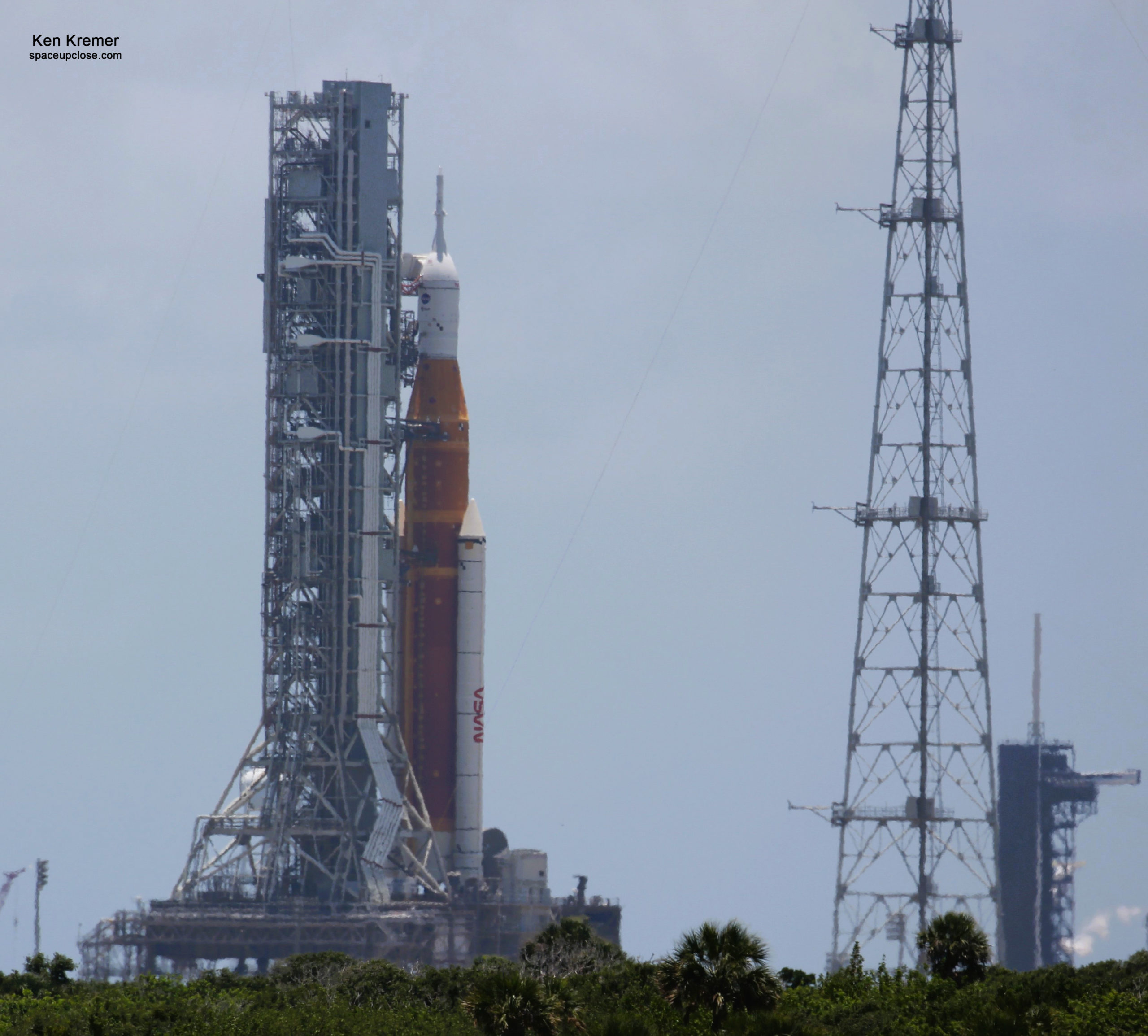
It will take about 8 to 10 hours to move the stack some 4.2 miles (6.8 km) from pad 39B to the VAB.
The Apollo era crawler-transporter-2 (CT-2) moves at a top speed of about 0.8 mph (1.3 kilometers per hour).
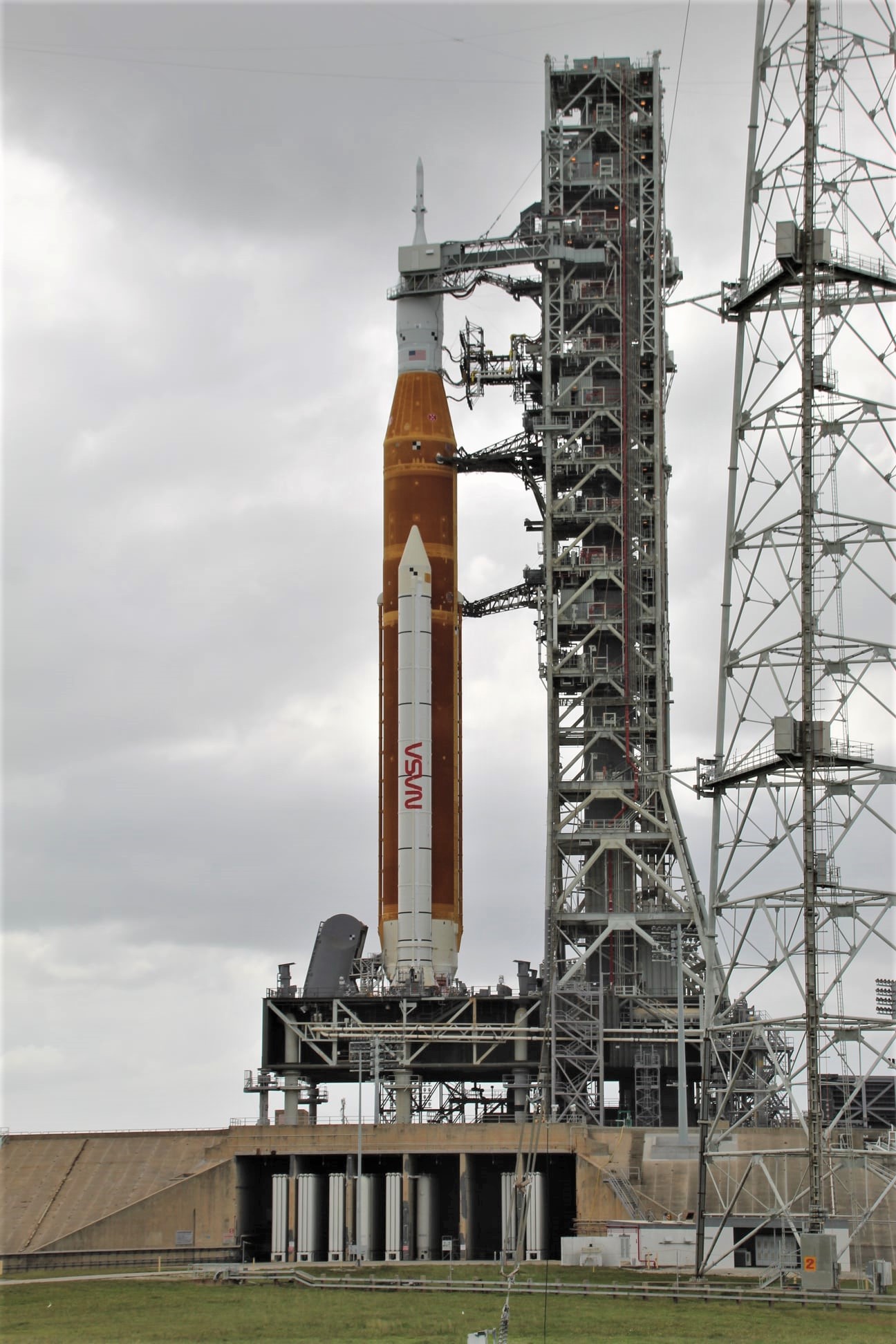
Inside the VAB technicians will then carry out 6 to 8 weeks of repair and refurbishment work and ready the duo for their 3rd rollout to Launch Complex 39B.
After SLS rolls back out for the 3rd time to pad 39B the team needs 10 to 14 days for pad preparations
However the FTS is only verified for 20 days starting from the VAB rollout day
They can do 3 launch attempts in 7 days out at the pad.
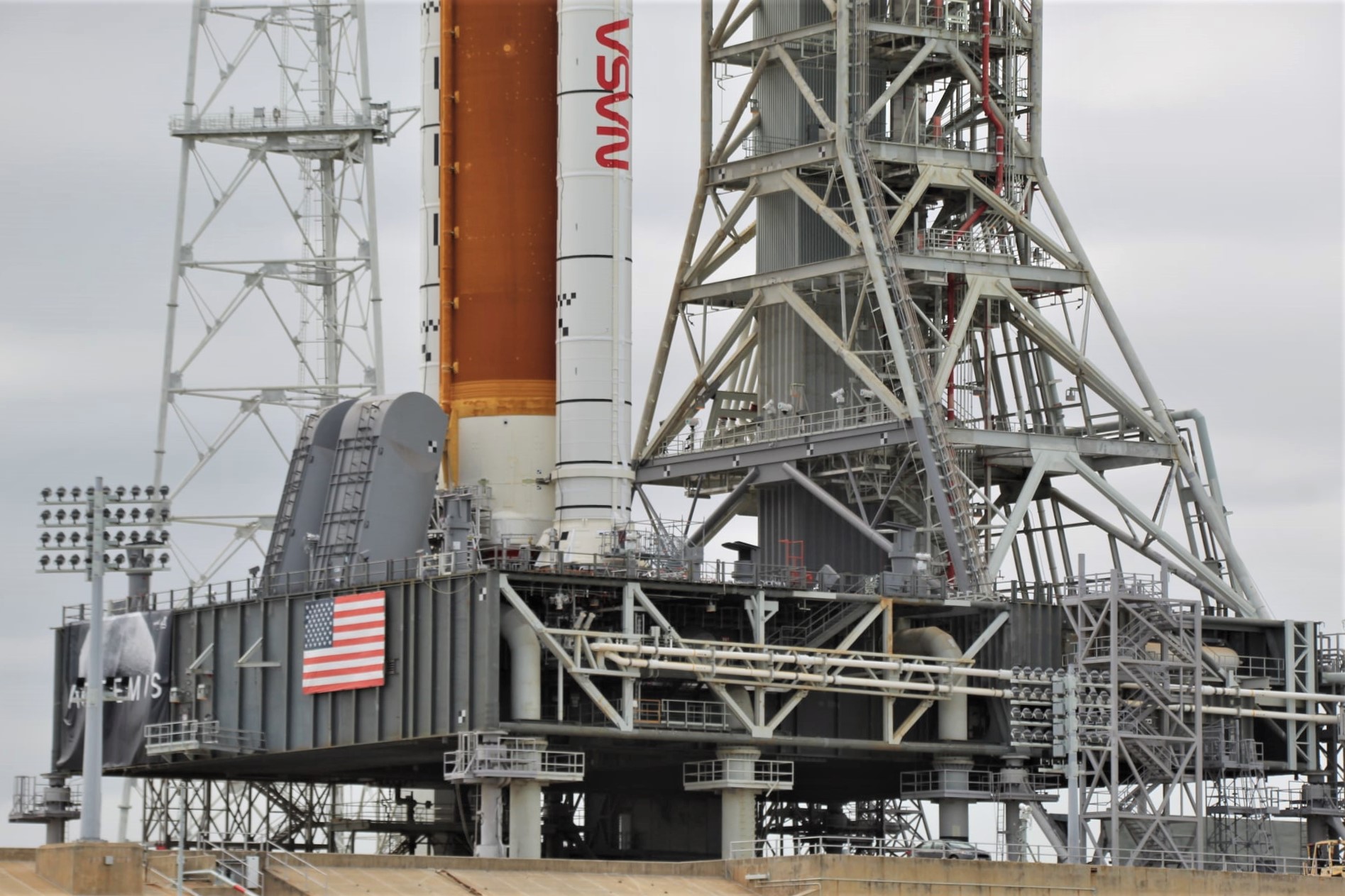
The team is currently targeting launch of the unpiloted Artemis 1 mission to the Moon and back for the late August/early September timeframe if all goes well.
“During the wet dress rehearsal activities, we have incrementally added to our knowledge about how the rocket and the ground systems work together, and our teams have become proficient in launch procedures across multiple sites. We have completed the rehearsal phase, and everything we’ve learned will help improve our ability to lift off during the target launch window,” said Tom Whitmeyer, deputy associate administrator for common exploration systems at NASA Headquarters.
“The team is now ready to take the next step and prepare for launch.”
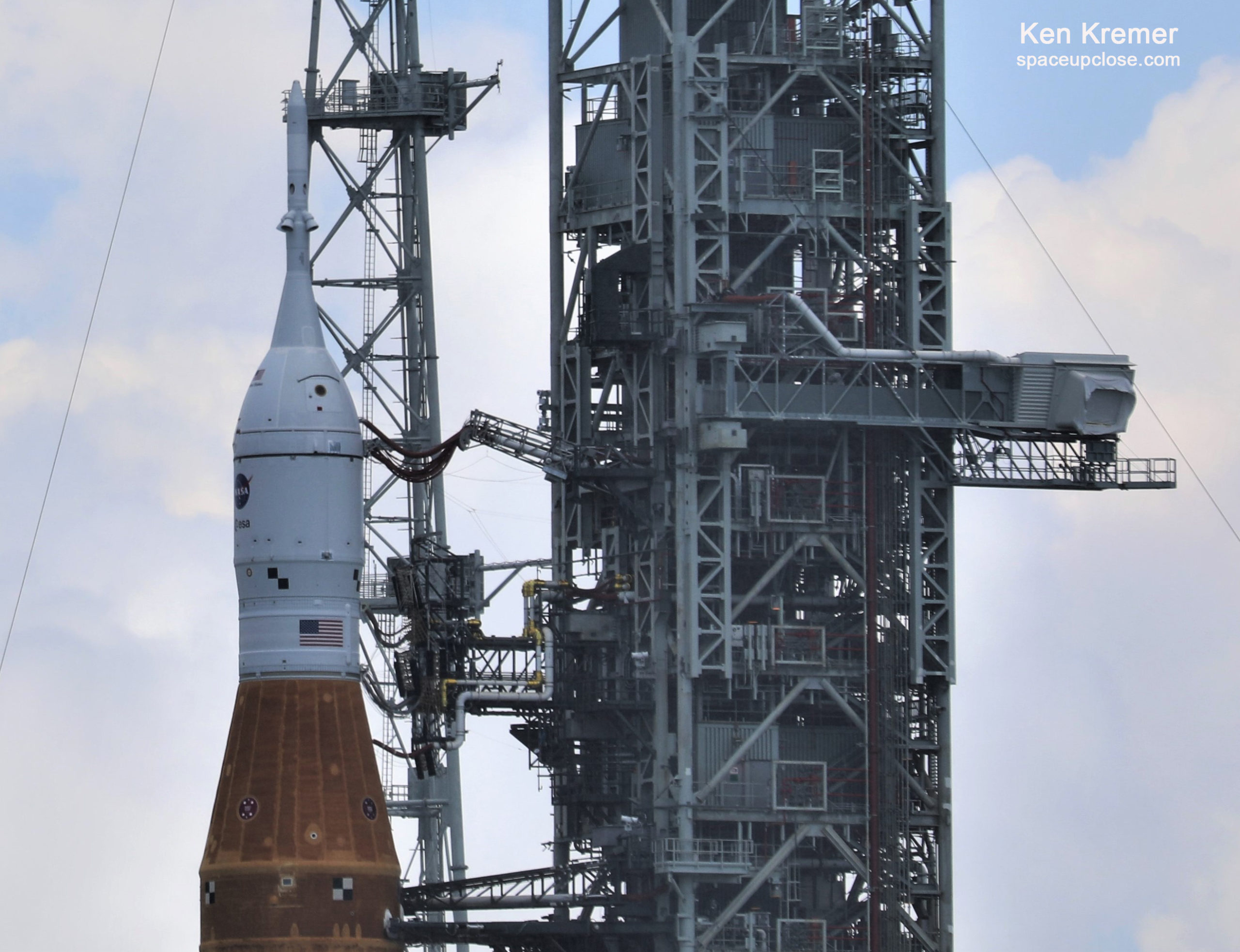
For the first time NASA was able to fully fuel both stages of the agency’s Mega Moon Rocket with supercold cryogenic propellants and enter the terminal countdown to within 29 seconds of T-Zero on Monday June 20, despite a hydrogen leak during the fourth attempt to complete the critical countdown and tanking test known as the Wet Dress Rehearsal (WDR) for the now repaired Space Launch System (SLS) Artemis 1 Moon rocket standing vertical at launch pad 39B at NASA’s Kennedy Space Center in Florida.
“Today’s test marked the first time the team fully loaded all the Space Launch System rocket’s propellant tanks and proceeded into the terminal launch countdown, when many critical activities occur in rapid succession,” NASA said June 20.
Thus the SLS launch team at KSC completed nearly all the primary and secondary objectives required for a successful WDR that now paves the way for NASA officials to decide to push ahead with preparations for the uncrewed Artemis 1 mission around the Moon later this summer, the team said at post test briefings June 21 and Jun 24.
They were also able to demonstrate replenish of propellants of both stages
“During Monday’s rehearsal, teams were able to validate the timelines and procedures for launch, including loading cryogenic – or supercold – propellant into the rocket’s tanks, performing the launch countdown through the handover to the automated launch sequencer, and draining the tanks.”
The rehearsal focused on two primary objectives and several secondary objectives to help ensure the team will be ready to launch on the Artemis I flight test.
Here are the primary and secondary objectives as outlined by the NASA KSC Artemis 1 Launch Director:
The primary objectives were:
- Demonstrate cryogenic loading operations through all phases of propellant loading and proceed into terminal countdown, perform a recycle to T-10 minutes, a second terminal countdown, scrub, and perform propellant drain operations and safing activities
- Demonstrate Kennedy facilities Launch Complex-39 and Launch Control Center in launch countdown configuration and demonstrate operations and connectivity required on day of launch with launch control team, support launch team, 45th Delta Space Force Eastern range, network, and design center support
Secondary test objectives include:
- Demonstrate successful Kennedy Launch Control Center interfaces with the Marshall SLS Engineering Support Center, Delta Operations Center of the 45th Space Force, and Johnson Flight Control and Mission Evaluation Room including communications, operational television for monitoring the rocket and spacecraft, and telemetry in launch day configuration
- Collect data on Orion, SLS and mobile launcher launch configuration loads, cryogenic induced deflection and thermal data during cryogenic load and drain, as well as imagery of vehicle performance
- Validate the timelines/procedures for roll-out and roll-back, launch countdown, launch window including time to complete a recycle and set-up for next T-0
- Collect data on electromagnetic interference and compatibility with vehicle and 45th Delta Space Force Eastern range systems configured for launch day during planned flight termination system testing
- Assemble and stage Red Crew, Fire Rescue Crews, Medical and other supporting launch teams
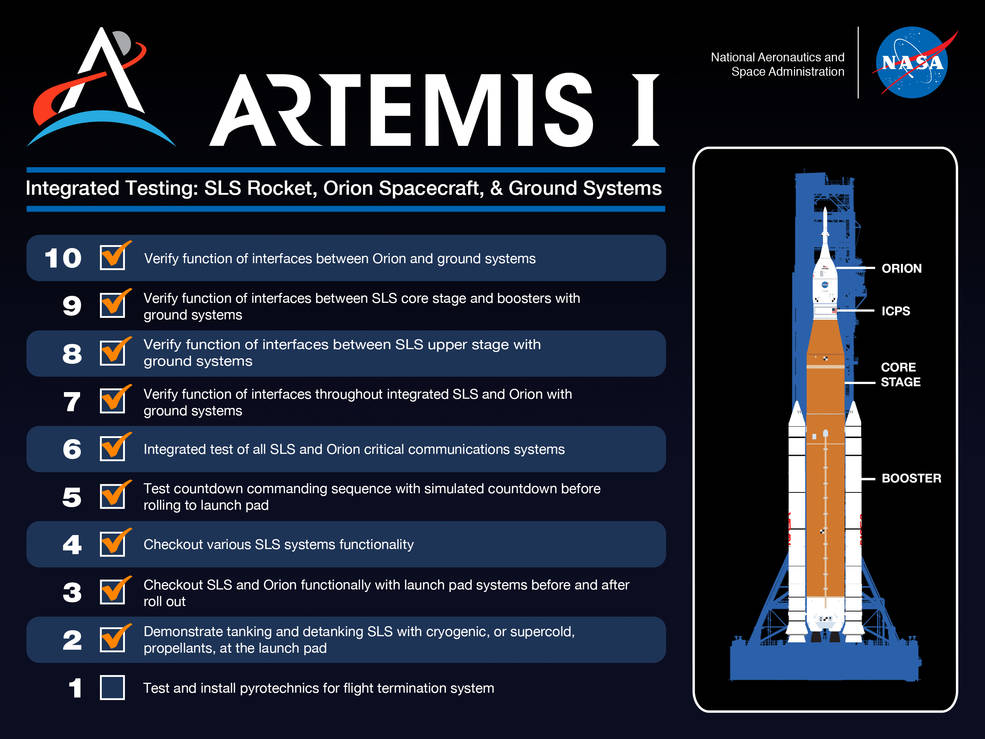
Artemis 1 WDR graphic. Credit: NASA
Further details from NASA:
By reaching deep into the final phase of the countdown, known as the terminal count when many critical activities occur in rapid succession, teams exercised all the assets and capabilities of the entire system: the SLS rocket, the Orion spacecraft, and Exploration Ground Systems including at Launch Complex 39B and other supporting locations.
Despite a liquid hydrogen leak detected earlier in the day when increasing pressure to condition the engines, teams were able develop a plan to proceed into the terminal count with the expectation the countdown would stop after handover to the flight software for the automated launch sequencer. The software performs checks to confirm the engine temperatures are within acceptable range up to the point of the engine start sequence at T-9.34 seconds and operated correctly to halt the countdown at any point if temperatures fall outside that range, just as it would during an actual launch attempt.
“The team continues to impress me with their and creative thinking and resourcefulness,” said Charlie Blackwell-Thompson, Artemis launch director at Kennedy. “Our Artemis launch team has worked quickly to adapt to the dynamics of propellant loading operations. With each milestone and each test, we are another step closer to launch.”
The launch director elected to do a single run through the terminal count due to the length of the day for the launch teams. With experience from loading operations and simulations, it is not necessary to perform a retest to demonstrate the ability to recycle and reset for another run through the terminal count. Additionally, as part of the normal procedures after the cut-off of the countdown, teams successfully completed a set of steps to “safe,” or stabilize and reconfigure, the rocket.
Engineers reviewed the few commands that would have been included within the remaining seconds of the countdown before the engine start sequence and determined those activities had been previously validated in other recent tests. The remaining commands were not part of the objectives, but the team has decided to incorporate additional checks earlier in the countdown as they fine-tune procedures, such as for engine purge bleed parameters and propellant feedline heaters used for conditioning the engines to a specific temperature range for launch. Performing these checkouts earlier in the countdown will provide the team with the best position to make the target launch window.
Before returning to the VAB, engineers will also add a checkout of the booster hydraulic power unit to provide additional data for the countdown schedule. The units contain hydrazine powered turbines attached to pumps that provide pressure to pivot the booster nozzles used for steering the rocket during ascent. The automated launch sequencer sends the command to start the hydraulic power unit at T-28 seconds, which would have occurred just after the point the flight software cut off the countdown at T-29 seconds.
Once inside the VAB, teams will replace a seal on the quick disconnect of the tail service mast umbilical to address a liquid hydrogen leak detected during the rehearsal. NASA plans to return SLS and Orion to the pad for launch in late August, and will set a specific target launch date after replacing hardware associated with the leak.
Artemis I will be the first integrated test of NASA’s deep space exploration systems: the Orion spacecraft, SLS rocket and supporting ground systems. As the first in a series of increasingly complex missions, Artemis I will pave the way for long-term exploration at the Moon in preparation for human missions to Mars.
…
The Space UpClose team of Ken Kremer and Jean Wright attended and witnessed the SLS/Orion 1st and 2nd rollouts from KSC Press Site and also witnessed the rollback return on April 26 to make the required repairs
Enjoy our photos of SLS/Orion rolling out and back between the VAB and pad 39B.
Read my earlier detailed stories about the rollout, rollback and repairs illustrated with our photos
NASA will set a launch date for Artemis 1 only after successfully completing the WDR
After this next WDR the SLS/Orion stack will again be rolled back to the VAB for refurbishments, installation of the FTS and any further repairs and other work needed to ready for the launch campaign
Liftoff is expected NET late August
Watch Ken’s commentary about NASA SLS WDR demo test, SpaceX missions including NASA Crew-3 and Crew 4, AX-1, Nilesat 301, Transporter-5, Starlink, Boeing Starliner, and NASA TROPICS 1.
Jun 21/22: WFTV ABC Orlando News featured my commentary about NASA’s 4th SLS WDR fueling attempt Jun 20, the results and whats ahead after NASA conducts detailed analysis of the 1st tanking test to completely load both stages with LOX & LH2 and run the terminal count to T-29 sec despite a hydrogen leak – achieving many but not all objectives
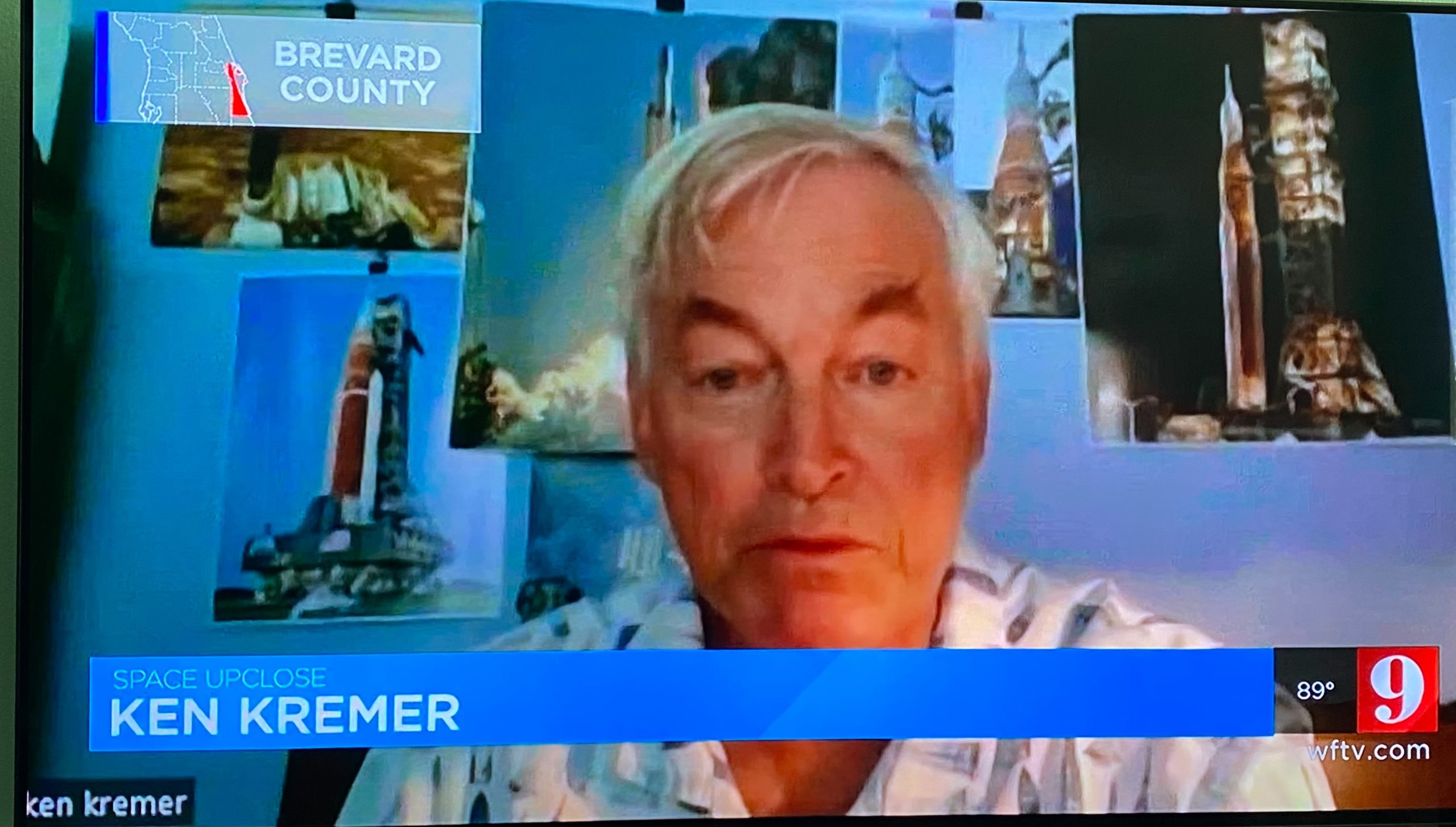
Jun 17: Fox 35 Orlando featured my commentary about the selection of 2 NASA astronauts to fly on the 1st crewed mission of Boeing Starliner capsule on CFT test flight late 2022 – and what it means for human spaceflight to have a 2nd US commercial crew provider following the successful Boeing Starliner OFT-2 mission for NASA
Jun 9/10: WFTV ABC Orlando features my commentary about the upcoming NASA TROPICS 1 & 2 cubesat science launch on an Astra Rocket 3.3 from pad 46 for NASA which will study the formation and evolution of Tropical Cyclones and Hurricanes. Two more launches will follow for 6 TROPICS cubesats altogether over next few months
Jun 8: WFTV ABC Orlando features my commentary about the SpaceX Falcon 9 launch of NileSat301 telecom sat for Egypt
June 6/7: WFTV ABC Orlando features my commentary about completing 2nd rollout to pad 39B for 2nd round WDR tanking test, what’s involved in and why its critical to the future of Project Artemis:
May 25/26: WFTV ABC Orlando featured my commentary about the successful ISS undocking and touchdown of Starliner on OFT-2 test flight
May 19/20: WFTV ABC Orlando and Fox 35 Orlando featured my prelaunch and post launch commentary about the critical nature of the Boeing Starliner OFT-2 mission for NASA
May 11: WFTV ABC Orlando News featured my commentary & analysis about Boeing Starliner crew capsule targeting launch May 19 for long delayed OFT2 uncrewed test flight for NASA after completing FRR this afternoon. It must dock at ISS to be considered successful to enable follow-on NASA astronaut flights maybe by late 2022
Apr 29: WKMG CBS 6 with my commentary about the record setting Falcon 9 turnaround of 21 days since the Axiom-1 launch
Apr 22: Fox 35 Orlando features my analysis of the busy week ahead in space with weather delayed Earth return of AX-1 crew this weekend, launch of 4 NASA/ESA Crew-4 astronauts on SpaceX Crew Dragon NET Apr 26 & rollback of NASA SLS to VAB for repairs
https://www.fox35orlando.com/video/1060937
Apr 20: WFTV ABC News Orlando features my commentary about the SpaceX static fire and impact of weather induced delays to departure of Ax-1 and launch of Crew-4.
Apr 15/16 & Apr 12/13: WFTV ABC News Orlando and WKMG CBS 6 Orlando featured my comments about NASA SLS WDR wet dress rehearsal countdown and fueling demo test and human launches to ISS:
Apr 6: WFTV ABC 9 Orlando featured my comments about 1st fully private astronaut launch to ISS by SpaceX on AX-1 mission:https://www.wftv.com/news/local/brevard-county/first-all-private-astronaut-mission-iss-set-liftoff-kennedy-space-center-this-week/FYE5QAT735BA7G42O6IVCJGB4Q/
Apr 4 & 5: WFTV ABC News Orlando and Fox 35 Orlando featured my comments about NASA SLS WDR wet dress rehearsal countdown and fueling demo test and human launches to ISS
https://www.fox35orlando.com/news/nasa-resumes-artemis-i-wet-dress-rehearsal-countdown
Watch Ken’s continuing reports about Artemis, SLS, Orion and NASA missions, SpaceX Crew and Cargo Dragons, SpaceX Axiom-1, JWST, IXPE, DART, Lucy Asteroid mission, GOES, SpaceX Starlink, Commercial Crew and Starliner and Crew Dragon, Blue Origin and Space Tourism, and onsite for live reporting of upcoming and recent SpaceX and ULA launches including Crew 1 & 2 & 3 & 4, ISS, Solar Orbiter, Mars 2020 Perseverance and Curiosity rovers, NRO spysats and national security missions and more at the Kennedy Space Center and Cape Canaveral Space Force Station.
Stay tuned here for Ken’s continuing Earth and Planetary science and human spaceflight news: www.kenkremer.com –www.spaceupclose.com – twitter @ken_kremer – email: ken at kenkremer.com
Dr. Kremer is a research scientist and journalist based in the KSC area, active in outreach and interviewed regularly on TV and radio about space topics.
………….
Ken’s photos are for sale and he is available for lectures and outreach events
Please consider supporting Ken’s work by purchasing his photos and/or donating at Patreon
https://www.patreon.com/kenkremer
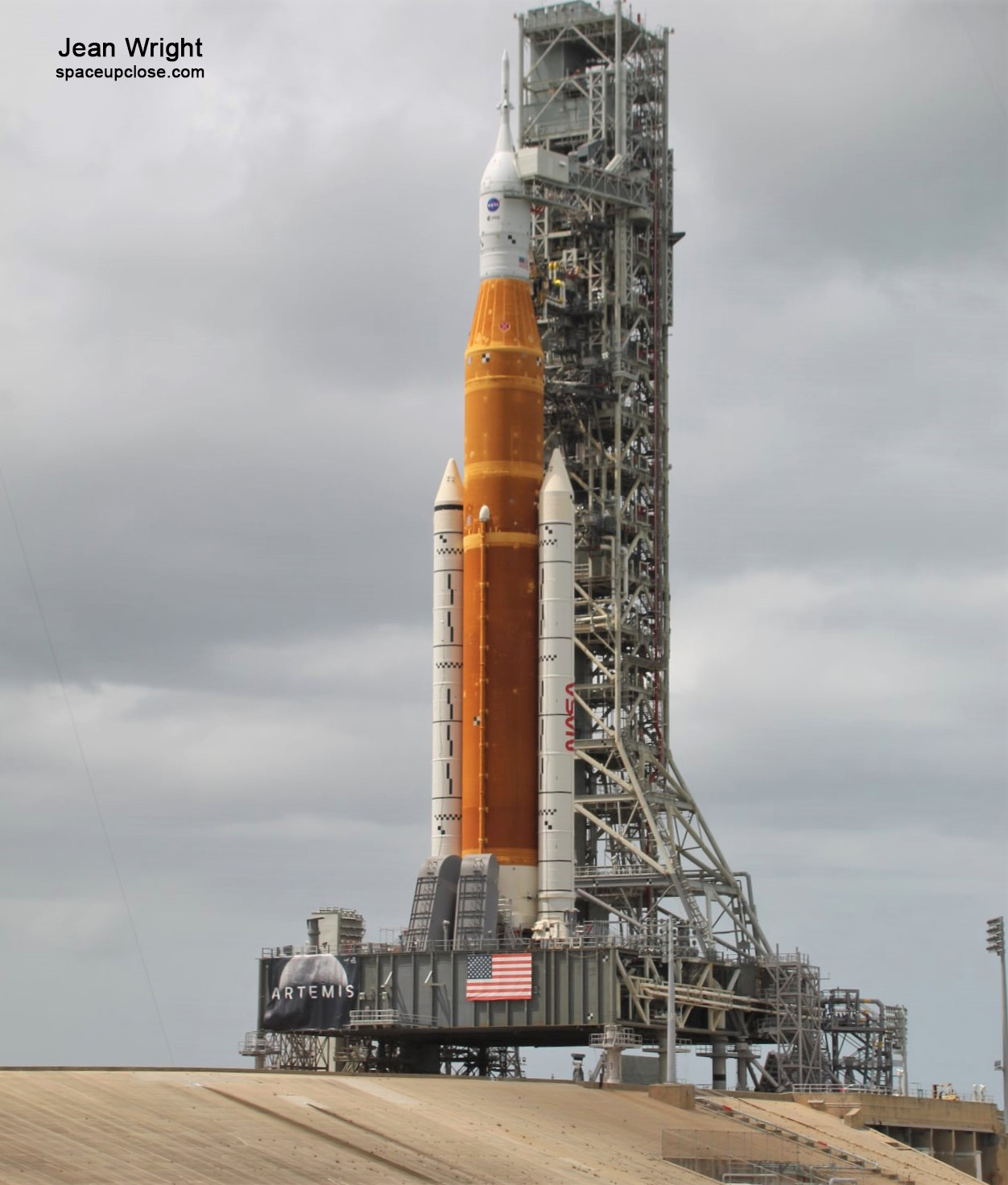
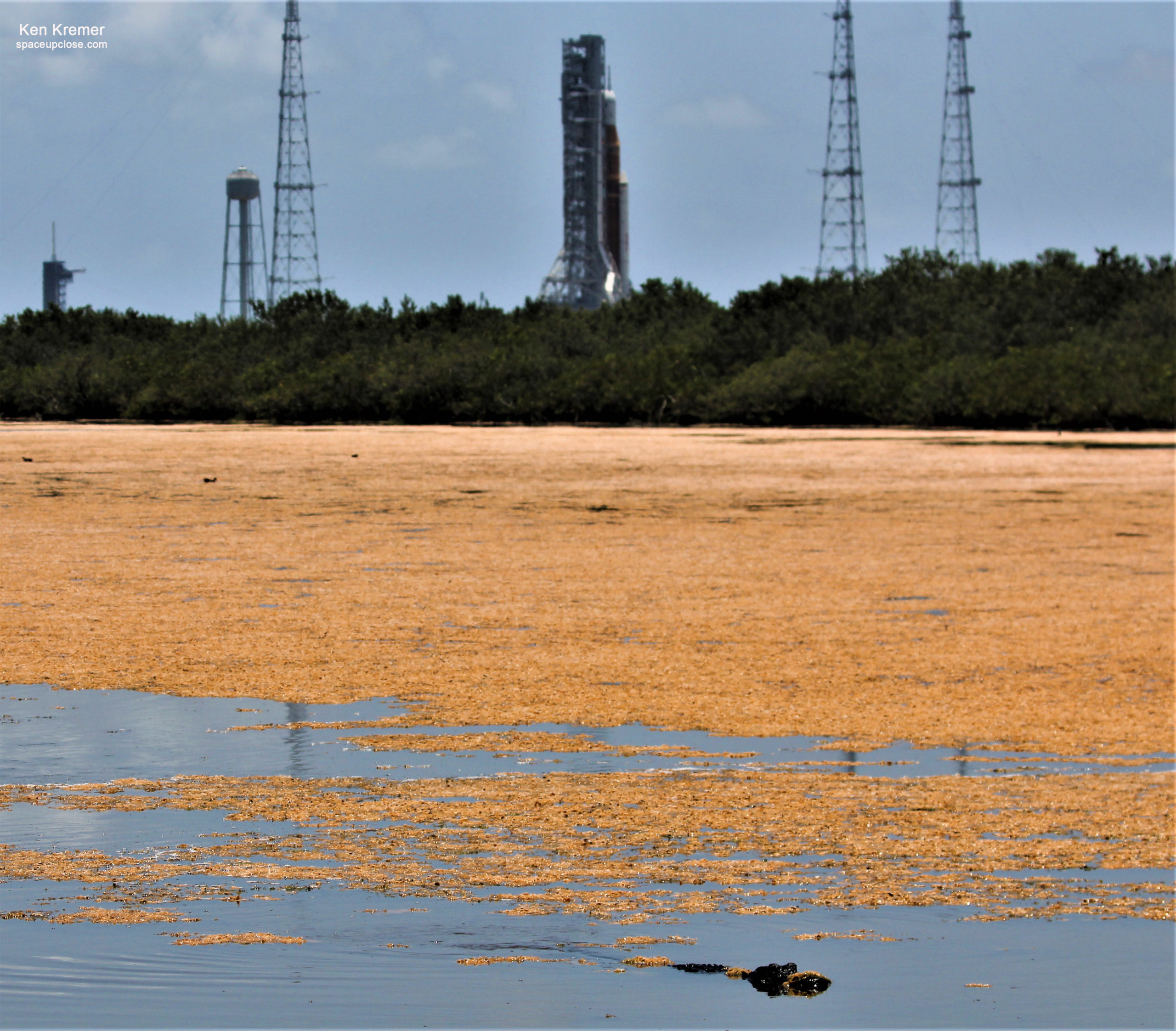
x



